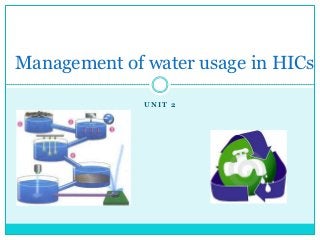
7 management of water usage in hi cs
- 1. Management of water usage in HICs UNIT 2
- 2. Specification details 5.3a The management of water usage: in HICs, in domestic, industrial and agricultural contexts.
- 3. What is the link between these pictures?
- 4. Water Saving Methods There are many ways of saving water Read through the information about different methods Put into 3 categories. Domestic Industrial Agricultural Check them and stick them into your books under the correct headings
- 5. Domestic Industrial Agricultural Collecting rain water in a Tap restrictors – valuable for Drip irrigation is very water butt means you do not providing equal flow at a effective, but very expensive, have to use a hosepipe as number of taps in a washroom. it delivers water straight to much, this could save 50,000 This reduces water flow by 15 the plant roots with minimal litres per year per cent. losses. Having a shower instead of a Push taps, ideal for public Loosening compacted soil bath can save up to 60 litres a areas, stops taps being left prevents surface run off and time running. This can prevent huge allows water to be absorbed wastage if the tap is dripping. into the soil Short flush toilet system can Urinal flush controls – Installing rainfall sensors so save 8 litres of water per controlling when they flush the irrigation systems only flush. can save up to £3800 on water operate when it is dry. bills. Economy setting on Shower regulators provide an Flood irrigation can give a very dishwashers and washing equal flow when lots of uneven distribution and machines saves a lot of water. showers are being used, saving overhead sprinklers lead to up to 20% evaporation of water before it is absorbed A water meter controls the Push button showers are ideal usage of water and allows for public areas where they people to see how much water may accidently be left on. they are using. Turning off taps when not needed, a running tap uses 10 litres a minute.
- 6. Stick this in you books and label the different ways houses in HICs can save water.
- 7. Case Study: Walkers Crisps Walkers Crisps have reduced its usage by 50% This is saving over 700,000,000 litres a year They did this by:- Installing 30 water meters at their factories, allowing them to monitor where and when water was being used They recycle the water from one part of the production, rather than wasting it They educated their staff about using water sensibly They assigned ‘water champions’ and ‘leak busters’ to each shift. It was VERY successful!
- 8. Extension Can you think of any water saving methods you could use in your home It could be new designs for old products, -or- New methods of saving water
- 9. Specification detail 5.3b The management of water resources (a dispute between countries, areas or within a country over water transfer).
- 10. How can water cause conflict? Conflict over water in the Middle East and the Zambezi basin : here
- 11. Map work Use a map and find two countries that share the same water source. Research this water source and discover if there is any conflict.